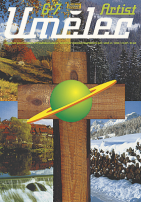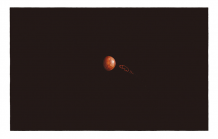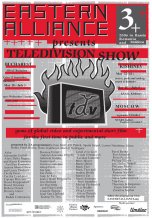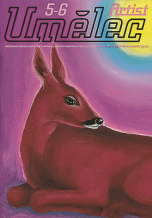| Zeitschrift Umělec 1998/6-7 >> Mongrelian Culture and Cultural Prestige or Ignorance and Filth in Digital Paradise | Übersicht aller Ausgaben | ||||||||||||
|
|||||||||||||
Mongrelian Culture and Cultural Prestige or Ignorance and Filth in Digital ParadiseZeitschrift Umělec 1998/6-701.06.1998 Miloš Vojtěchovský | media | en cs |
|||||||||||||
|
At the recent Ars Electronica festival, the topic talked about, written about and discussed was information war flooding mass and other media. It was considered a metaphor for communication and existential way of mankind at the end of the 20th Century. From the view, technology, embodied by the holy trinity of electronics, telecommunication and computers, is living on mainly research and logic of the warfare art – clashes in attempt to maintain influence, hegemony, control, eliminating the enemy. The elegant silicon mask of machines for virtual reality hides a battle in which the award for the winner consists of control and data distribution, concentration of capital, and distribution of information, clash of interest groups in the economic sphere, production monopoly, maintaining the information society in constant consumer flow, political passiveness and stress caused by fear of local or global military conflict. Present at the symposium were Tim Druckery, Lucky Green, Friedrich Kittler, the RTMark, Douglas Rushkoff, Paul Virilio, Derrick de Kerckhove, Geert Loving and many other big names and media activists. Sponsored by producers of digital and political technology, Ars Electronica seems as if turning against its benefactors and presents a chaotic subculture of hackers and other subversive elements that have a bit untraditional approach to technology and use it in a way which is not exactly listed in the users guides.
The Cyberarsts 98 exhibition in the O.K. Center included artists such as Paul Garrin and David Rockeby who created a playful and interactive version of all jail or border walls. The work entitled Border Patrol immediately captures you walking in, using a system of sensors and cameras and then within seconds you are destroyed on TV screens. Entering the 3D projection room the Cave in the A.E. Center, you visit a sort of digital warfare safari called World Skin which is made by Maurice Benayoun and Jean Baptiste Barriére. The photographs of figures positioned in a country are elegantly printed out but instead of the figures it leaves only a white outline. Camera as a weapon. Ground Truth is an installation and an internet simulation of a war field in which players may control an imaginary military conflict using a joystick. The installation reminds of the Gulf War between U.S. Army and Iraq. The similarity to computer games, however, significantly plays down the effect which is also the case of the digital model of urban dynamics of 10 Denis in Tokyo by Knowbotic Research. Shooting phantoms and avatars on the run is such an overused production and marketing strategy today that it is on the verge of banality. If Ars Electronica is a bit of a trade fair for latest products in hi-tech applied in arts, the parallel event, Hybrid Factory, organized on the outskirts of the city of Linz by former Ars Electronica curator Gottfried Hattinger offers completely different atmosphere. The reconstructed factory building provided space for a group of completely low-tech artists who made a sort of manufacture and shop for products made on the site. Laura Kikauka and Gordon Monahan brought a temporary version of the Berlin Fun Factory full of colorful, glittering, nonsensical tools and gadgets made from commonplace cheap things. The peak of Jurassic technology was represented by a machine for vibrating everything, attached to a little shop of one of the workers of the Hybrid Factory. You could also buy a perfume called Cash by Robert Jelinek which proves that money doesn’t smell. The Mongrel group presented an interesting, complex and strong project in Linz, consisting of both posters and net presence. Mongrel is a bunch of anarchistic hacker artists-activists from London who focus on low street art. They work with text, images, software and hardware in public space. The themes they are dealing with include racism, violence, genetic manipulation, post-colonialism and other uncomfortable social and political topics which are as out-of-place in the white Arian digital paradise as muddy rain boots worn at a cocktail party. They cooperate with various cultural initiatives but the core of the group are Matsuko Yokokoji, Richard Pierre-Davis and Graham Harwood. Out of the three, Hardwood is perhaps the most famous. He is known for the computer comics CD If Comics Mental and Rehearsal of Memory which he made based on his work and experience in Ashword jail for mentally disabled convicts. This work was awarded a number of prizes and attracted attention at many media festivals. It was also presented at the Dawn of Magicians exhibition at the Modern and Contemporary Art Collection of the National Gallery in Prague. The Natural Selection project (a Darwinist filiation perhaps?) was created by Hardwood and Mathew Fuller. The title Mongrel was most likely provided by Hakim Bey, the godfather of anarchistic imedialists. In a parallel article Islam and Eugenics which forms sort of a pamphlet for racial and cultural crossing, he states that ”mongrelization”, i.e. hybridization of white, black and Mongolian races, may be found throughout history of mankind but sufistic Islam is a prototype of antiracist syncretion. Who knows? In any case, Mongrel hacked an internet search engine so that everybody who takes part in internet communication focused on racist, fascist pornographic and other pathological issues is sent to parallel Mongrelian web sites confronting him with an antagonistic story told from the perspective of the minorities at issue. Natural Selection, however, is only one of the projects. Posters, newspapers, and similarly a web site present text and images that Mongrel works with. It is an example of not yet realized interactive installation exploring the racial issue and manipulating human being’s image through visual media. The archetypal magic of facial appropriation reflects here into a model of social and scientific eugenics. The camera installed at the entrance captures a digital image of the person walking in. The picture is then analyzed as to the person’s racial background and projected on walls. Simulation of saliva stains on the face – an expression of aggression and inferiority – is made using a special program, as is movement of the eyes that follow viewer of the installation. The hybrid movement of the surgical transplantation of a face of a white man, black man and a Mongolian man on one’s own face enables to experience a model situation in which the dichotomous minorities find themselves. The project is still in the phase of research yet the web site www.mongrel.org.uk shows the truly effective and innovative usage of technology for hot issues of human relations. The various possibilities of this project’s presentation – a gallery, internet, a street, newspapers – also lowers the social isolation of the work and brings it closer to the groups of people it actually addresses. Artists of other races (except for the Japanese) have hard time getting to the prestigious events such as Ars Electronica. The anarchistic credo of the Mongrel group can be detected from their statement to the current situation and reign of universal taste: ”Critical dialogues in the English art scene between its professionals - curators and artists - and its audience clearly rely on a set of historical principles produced during Hegel’s era, a period when slavery, bond servantry and forced child labor were still a large part of western civilization. Hegel wrote that blacks ‚do not have the ability to appreciate the necessary mystery involved in the creation of truly symbolic art, thus placing them outside the realm of authentic aesthetic sensibility‘. We need to destroy the boundaries put into place by specific arts discipline, professionalization and the hierarchy of taste. We can start by inviting in the mongrel forms of culture with their diverse and inclusive ‚filthy‘ social relations. We can deal with the rotting carcass of Hegel’s ‚truly symbolic art‘ by burying it.” (Harwood). Using the Natural Selection search engine, I came across a few Czech internet sites by typing in the word Gypsy. Dumb conversation of some managers including Gypsy jokes was an accidental symptom of Czech racism on the net. Since I didn’t have much time, I didn’t look further but I think that Mongrel would have something to say in this country. It is typical that the project organized by the Soros Center for Contemporary Arts just barely touched the issue of racism. The corpse of the hegelian ”truly symbolic art” can be sensed in the galleries and on the streets. A bit darker interpretation of the race issue can be found in the work of Moscow’s AES group entitled The Vision of the Future – World According to Mr. Huntington. Huntington is a political science professor at Harvard who claims that ethnic clashes between civilizations are almost impossible to solve. He points out nine relevant cultures: Western, Orthodox, Islamic, Confucian, Buddhist, Japanese, African and Latin-American. Clash between Western and Islamic cultures are, according to him, most dramatic and metaphorically speaking they are about a battle between MacWorld and Jihad. The AES group – Tatiana Arzamasova, Leo Evzovich, Evgenyi Sviyatski) illustrated professor’s vision in a series of 12 postcards. Famous and media attractive places of Western culture are presented in a way they would look like after 2006. They say that the project is not driven by an anti-Western or anti-Islamic ideas, it only plays with our xenophobia concerning a possible influence of Orient on our civilization. It is an ironic persiflage on catastrophic scenarios of the leaders of dominant white race and as such it had quite awkward response and was attacked by both Moslems and the American protectors of political correctness. Leo Evzovich reacted: ”Life is not politically correct so why should art be? Most people may interpret the project without falling into polarity either-or. Political correctness is often a form of censorship. It seems to me that our work has its comical side to it which may help people look away from the conflicts between Western world and Islam.” Fundamentalism on both sides of the front creates obstacles to freedom, independence of thought and communication between individuals, claiming in a Mormon style that God is with us against Barbarians. Hybrid fusion of culture in urban environments or on the net is, indeed, more Oriental than transcendent and universal in Hegelian style. Hakim Bey takes this fact with satisfaction: ”’Islam’ in Europe and America? Why not? Why not enjoy it? Autonomous enclaves in Berlin, Paris, London – linked by anarcho-federalism with other autonomous zones, squats, social centers, eco-farms, free rural municipalities, other anti-capital entities and non-hegemonic particularities... . Why not something else, the ‚Spirit of Sarajevo‘ perhaps” (as a multicultural city?). Given the current state of Sarajevo, this seems to be more of utopia. (pages 8 through 9)
01.06.1998
Empfohlene Artikel
|
|||||||||||||
|
04.02.2020 10:17
Letošní 50. ročník Art Basel přilákal celkem 93 000 návštěvníků a sběratelů z 80 zemí světa. 290 prémiových galerií představilo umělecká díla od počátku 20. století až po současnost. Hlavní sektor přehlídky, tradičně v prvním patře výstavního prostoru, představil 232 předních galerií z celého světa nabízející umění nejvyšší kvality. Veletrh ukázal vzestupný trend prodeje prostřednictvím galerií jak soukromým sbírkám, tak i institucím. Kromě hlavního veletrhu stály za návštěvu i ty přidružené: Volta, Liste a Photo Basel, k tomu doprovodné programy a výstavy v místních institucích, které kvalitou daleko přesahují hranice města tj. Kunsthalle Basel, Kunstmuseum, Tinguely muzeum nebo Fondation Beyeler.
|



































 We Are Rising National Gallery For You! Go to Kyjov by Krásná Lípa no.37.
We Are Rising National Gallery For You! Go to Kyjov by Krásná Lípa no.37.
Kommentar
Der Artikel ist bisher nicht kommentiert wordenNeuen Kommentar einfügen